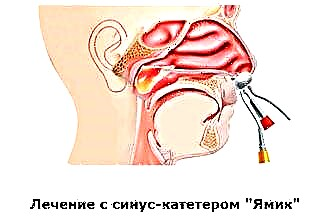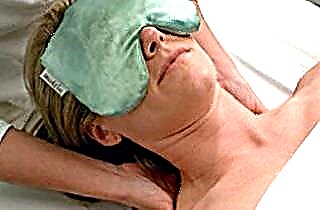Sinusitis is one of the most common diseases of the nasal system. According to researchers, up to 10% of the world's population is sick with it, regardless of race, age and gender. This is one of the varieties of sinusitis, the essence of which is inflammation of the internal mucous membranes of the maxillary sinuses due to blockage of the connective anastomoses and deterioration of the outflow of mucus up to stagnation. In this case, there are problems with nasal breathing. Further, we will take a closer look at the question of whether the nose breathes with sinusitis.
The reasons for the development of the disease
 The presence or absence of nasal breathing in sinusitis largely depends on the cause of the ailment. The most common are:
The presence or absence of nasal breathing in sinusitis largely depends on the cause of the ailment. The most common are:
- infections: viruses and bacteria (staphylococci, pneumococci, streptococci, mycoplasmas and chlamydia);
- complication of acute respiratory infections and acute respiratory viral infections, untreated or transferred on the legs;
- chronic tonsillitis (inflammation of the tonsils) or pharyngitis;
- spread of infection from the oral cavity from diseased teeth of the upper jaw;
- the development of allergic rhinitis with inappropriate therapy;
- anatomical individual characteristics of a person (narrowed nasal passages, deformation of the nasal septum, consequences of injury or surgery);
- significant pressure drops (when diving or flying).
The development of sinusitis mainly occurs against the background of a respiratory illness, so the patient may not even suspect that his air pockets are inflamed until the symptoms become pronounced. Anyone with a weakened immune system can become a victim of an illness.
Sinus congestion
Nasal breathing with respiratory diseases and sinusitis is most often difficult. This is due to the specific structure of the airway sinuses, which are hollow inside pockets that are connected to the nasal cavity with special channels (fistulas). A distinctive feature is that relatively large sinuses (average volume about 15-20 cubic centimeters) are connected to the nasal cavity by very thin channels (1-3 mm in diameter, depending on the physiology of each person).
Pathogens entering the sinus lead to edema of the mucous membranes of the anastomoses, which become even narrower or completely overlap. Because of this, the drainage of the cavity deteriorates or stops, stagnation occurs and the accumulation of secretions with purulent discharge. A favorable environment for the multiplication of viruses and bacteria is formed, all mucous membranes swell, and for this reason it becomes difficult to breathe through the nose. Whether he breathes at all depends on the severity of the edema.

The presence of a large volume of secretions is added to the edema, which further blocks the respiratory process.
Snot is released from the maxillary sinuses during inflammation of the mucous membranes, when the cilia of the ciliated epithelium work with maximum load, trying to evacuate the accumulating exudate. By the color of the snot, you can determine the stage and severity of the inflammatory process in the sinuses:
- White or transparent. They characterize the initial stage of the disease, do not contain pus. A thick consistency of white discharge and a gradual decrease in their amount indicates a stage of recovery. A clear secret is usually a sign of allergic sinusitis. Such discharge is also typical for rhinitis, therefore, the inflammation of the accessory cavities can be quite difficult to "see" at an early stage and to differentiate it from the common cold or runny nose.
- Yellow or greenish tint. They have a thick consistency, often come off in clots. Indicate the addition of a bacterial infection and an acute form of the disease. A yellow tint to the discharge is given by the presence of pus in the discharge.
- Gray-green. A sign of an advanced stage of the disease, in which the swelling of the anastomosis almost completely stopped the drainage of the sinus. Mucus mixed with pus stagnates and acquires an unpleasant odor, possibly the presence of blood streaks and clots.
Sinusitis without a runny nose
As a rule, a runny nose accompanies inflammation of the maxillary sinuses throughout the entire period of the disease and is one of its distinctive features. However, there are often cases when all the signs of sinusitis are present, the nose is stuffy and does not breathe fully, and there is no discharge. There are several reasons for this development of the situation:
 Anomalies of the anatomical structure of the nose, consisting in a significant curvature of the septum, disturbances in the anatomy of the turbinates, synechiae or postoperative scars that impede the outflow of fluid or greatly alter it, for example, removing the secretion closer to the nasopharynx, which creates the appearance of the absence of snot.
Anomalies of the anatomical structure of the nose, consisting in a significant curvature of the septum, disturbances in the anatomy of the turbinates, synechiae or postoperative scars that impede the outflow of fluid or greatly alter it, for example, removing the secretion closer to the nasopharynx, which creates the appearance of the absence of snot.- Too strong inflammation, which leads to a complete overlap of the anastomosis due to edema. Also, the excretory canal can be inherently too narrow and therefore easily susceptible to blockage. With the complete cessation of drainage, a very rapid accumulation of pus occurs. Without urgent medical attention, the exudate can even destroy the chamber wall and break into the surrounding tissue, causing serious consequences.
- Allergic reactions of the body can also, due to hyperemia and edema, disrupt the drainage of voids and lead to the development of an ailment.
- Complication after improperly treated viral infections (rubella, measles and especially influenza). The mechanism of the problem is as follows. Against the background of the underlying disease, the mucous membrane swells and blocks the chamber, where exudate begins to accumulate. Under the influence of antiviral drugs, the patient's condition improves significantly, the visible symptoms disappear, and there is a feeling of complete recovery. However, signs of inflammation of the maxillary cavities soon appear, in the first 1-2 days without the presence of snot, and then immediately with purulent contents.
- Overgrown tissues (cysts and polyps), malignant tumors, bone fragments or foreign objects that have gotten inside are also capable of mechanically blocking the connective canal.
- In the case of the transition of infection from diseased teeth with periodontitis, caries, pulpitis, osteomyelitis, the direction of development of sinusitis changes: the inflammation moves from the sinus wall to the anastomosis.
- Atrophic course of the disease. Consists in a violation of the performance of ciliated cells of the epithelium of their main functions - heating and purifying the air, excreting mucus and evacuating it into the nasal passages.
How to solve the problem of nasal congestion
Taking into account the complexity of the symptoms of the disease, a significant relief of nasal breathing on an ongoing basis is possible only when the pathogen is suppressed and the symptoms are eliminated. For the correct diagnosis and determination of the complete clinical picture of the disease, the otolaryngologist prescribes an X-ray or computed tomography of the airways, a general blood test and a smear from the mucous membrane for bacterial culture to determine the pathogen. Endoscopic rhinoscopy is also required.
Based on the results of the study, the ENT doctor determines the strategy for treating the disease. There are two areas of sinusitis therapy: medication and surgery.
 Conservative therapy consists in counteracting the edema of the mucous membranes, ensuring the timely removal of secreted secretions, restoring nasal breathing, and fighting pathogens. It includes taking such medications:
Conservative therapy consists in counteracting the edema of the mucous membranes, ensuring the timely removal of secreted secretions, restoring nasal breathing, and fighting pathogens. It includes taking such medications:
- Antibiotics for bacterial infection. The most commonly used tableted penicillins and macrolides (Amoxiclav, Erythromycin, Augmentin). New generation drugs (Flemoxil Solutab, Macropen, Zitrolide) have proven themselves well.In severe cases of the disease, injectable antibiotics-cephalosporins (Cefaclor, Cephalexin) are used.
- Decongestants. They reduce blood flow to the affected tissues, constrict blood vessels and reduce congestion, and are used for all types of sinusitis. The most common are Nazivin, Oxymetazoline, Rinazolin. However, it is undesirable to use these funds for more than 7 days.
- Mucolytics. By actively acting on the secret, they reduce its viscosity and facilitate evacuation from the accessory chamber. Produced in the form of syrups and drops (Fluditek, Mukodin), they accelerate recovery and have no side effects.
- Analgesics. High fever and severe pain syndrome are indispensable companions of sinusitis. You can fight them with the help of anti-inflammatory pain medications (Paracetamol, Ibuprofen, Aspirin). Due to the presence of certain contraindications, they can only be taken as directed by a doctor.
- Corticosteroids. They help well with bacterial, viral and allergic forms of sinusitis. They are effective for severe inflammation and affect the immune system. The most commonly used nasal spray Nasonex, however, due to side effects, its dosage must be determined by a doctor.
To restore nasal breathing, local therapy is used, which consists in diluting the secretion, removing it and then disinfecting the nasal cavity. A rough diagram looks like this:
- the nasal passages are flushed with a hypertonic saline solution (Aqualor Strong);
- irrigation with Rinofluimucin;
- after a few minutes, rinsing with isotonic saline solution (Aqualor soft shower or other means);
- irrigation with local antibiotics and antiseptics (Polidexa, Izofra, Miramistin).
In a hospital setting, washing is carried out in two ways:
 With the help of the Yamik sinus catheter. The device consists of two cylinders with rigid valves and a syringe attachment. The posterior balloon is inserted into the nasopharynx, and the anterior balloon is inserted into the nasal passage. A syringe is pumped out of the nasal cavity, as a result of which the resulting vacuum opens the anastomosis, and the accumulated exudate enters the nasal cavity, from where it is removed with the same syringe. The manipulation is used from the age of 5 and is carried out under local anesthesia.
With the help of the Yamik sinus catheter. The device consists of two cylinders with rigid valves and a syringe attachment. The posterior balloon is inserted into the nasopharynx, and the anterior balloon is inserted into the nasal passage. A syringe is pumped out of the nasal cavity, as a result of which the resulting vacuum opens the anastomosis, and the accumulated exudate enters the nasal cavity, from where it is removed with the same syringe. The manipulation is used from the age of 5 and is carried out under local anesthesia.- With the help of the "Cuckoo" device. A suction aspirator inserted into the nostril creates negative pressure in the nasal cavity. The doctor injects a solution (saline with the addition of drugs) into the other nostril with a syringe. Low pressure accelerates the circulation of the fluid, the thinned mucus flows through the other nostril into the suction.
Surgical intervention is used in the most severe cases, as well as in case of ineffectiveness of conservative therapy. The surgical method consists in making a puncture (puncture) in the thinnest place of the medial sinus wall by an otolaryngologist with a special syringe. After that, the sinus is washed through the needle, and drugs are injected. Puncture greatly facilitates the patient's condition, including improving the patency of the nose. The operation can be repeated within 2-3 days.
Herbal medicine and traditional medicine for nasal congestion
Natural preparations have been very popular in recent decades. In pharmacies, their choice is wide enough. Unlike pharmacological agents, they have practically no side effects, except for individual intolerance to the ingredients. The most famous are:
- Sinupret. It is based on extracts of black elderberry, verbena, primrose, sorrel. Has anti-inflammatory and antimicrobial effects, stimulates the immune system.
- Sinuforte. Based on cyclamen root extract. Irritates the receptors of the mucous membrane, promotes increased secretion, liquefaction of mucus and its excretion from the chambers. It is necessary to consult a doctor before taking medication so as not to cause pain.
Treatment of sinusitis with alternative methods is aimed at reducing the swelling of the mucous membrane and ensuring the outflow of secretions from the accessory pockets. The three main methods are inhalation, rinsing, and instillation.
- One teaspoon of propolis tincture is diluted in a glass of water.
 The nose is washed three times a day with a solution for a week.
The nose is washed three times a day with a solution for a week. - Combine callanchoe and aloe juice in a 1: 1 ratio and instill 3 drops in each nostril for 5 days.
- Make a medicinal collection of 2 g of St. John's wort, 5 g of yarrow, 2 g of celandine and 3 g of chamomile flowers. Pour the mixture with a glass of boiling water, bring to a boil and set aside. Conduct steam inhalation for 5-10 minutes.
- Add 5-6 bay leaves to 1 liter of boiling water, boil for 5 minutes, then breathe over the steam.

 Anomalies of the anatomical structure of the nose, consisting in a significant curvature of the septum, disturbances in the anatomy of the turbinates, synechiae or postoperative scars that impede the outflow of fluid or greatly alter it, for example, removing the secretion closer to the nasopharynx, which creates the appearance of the absence of snot.
Anomalies of the anatomical structure of the nose, consisting in a significant curvature of the septum, disturbances in the anatomy of the turbinates, synechiae or postoperative scars that impede the outflow of fluid or greatly alter it, for example, removing the secretion closer to the nasopharynx, which creates the appearance of the absence of snot. With the help of the Yamik sinus catheter. The device consists of two cylinders with rigid valves and a syringe attachment. The posterior balloon is inserted into the nasopharynx, and the anterior balloon is inserted into the nasal passage. A syringe is pumped out of the nasal cavity, as a result of which the resulting vacuum opens the anastomosis, and the accumulated exudate enters the nasal cavity, from where it is removed with the same syringe. The manipulation is used from the age of 5 and is carried out under local anesthesia.
With the help of the Yamik sinus catheter. The device consists of two cylinders with rigid valves and a syringe attachment. The posterior balloon is inserted into the nasopharynx, and the anterior balloon is inserted into the nasal passage. A syringe is pumped out of the nasal cavity, as a result of which the resulting vacuum opens the anastomosis, and the accumulated exudate enters the nasal cavity, from where it is removed with the same syringe. The manipulation is used from the age of 5 and is carried out under local anesthesia. The nose is washed three times a day with a solution for a week.
The nose is washed three times a day with a solution for a week.

